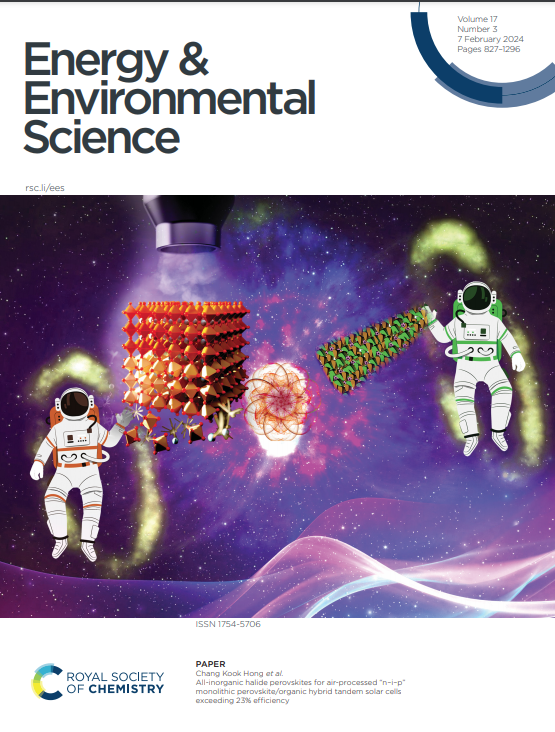Oxygen-tuned aluminum-based halide solid electrolytes enabling low-voltage anode compatibility in all-solid-state batteries
IF 32.4
1区 材料科学
Q1 CHEMISTRY, MULTIDISCIPLINARY
引用次数: 0
Abstract
Developing solid electrolytes with a wide electrochemical window, high ionic conductivity, and facile processability is essential for realizing high-energy-density all-solid-state batteries. In this work, we report a new family of aluminum-based oxychloride solid electrolytes with tunable oxygen/chlorine ratios, designed to overcome the critical reduction instability that limits the widespread adoption of halide-based electrolytes. Our study on the series of oxychlorides elucidates a complex tradeoff between oxygen content and electrolyte performance, particularly reduction onset potential and ionic conductivity. While increased oxygen content in the electrolyte delays the onset of reduction, it also induces strong propensity in Al–O bond formation, which simultaneously promotes the segregation of chlorine-rich impurities such as LiCl. Notably, we find that this residual LiCl phase initiates reductive decomposition, prematurely triggering electrolyte breakdown. Guided by this insight, we identify an optimized composition, Li1.1AlO1.1Cl3, that balances reduction stability and ionic conductivity. This new electrolyte enables stable cycling with a conventional 0.6 V-class alloy anode without requiring a secondary anolyte, delivering 188.8 mAh g−1 (LiNi0.8Co0.1Mn0.1O2 cathode) with 80% capacity retention over 250 cycles. More strikingly, it also supports stable operation with a low-voltage 0.3 V-class anode in the same solid-state configuration, achieving ∼91.5% capacity retention after 100 cycles, representing one of the most stable cycle performances reported for halide-based solid electrolytes paired with low-voltage anodes. These findings redefine the anode compatibility of halide solid electrolytes and point toward new design principles for next-generation solid-state battery systems.

氧调谐铝基卤化物固体电解质,可在全固态电池中实现低压阳极兼容性
开发具有宽电化学窗口、高离子电导率和易于加工的固体电解质是实现高能量密度全固态电池的必要条件。在这项工作中,我们报告了一种具有可调氧/氯比的铝基氯氧固体电解质的新家族,旨在克服限制广泛采用卤化物基电解质的临界还原不稳定性。我们对一系列氯氧化物的研究阐明了氧含量和电解质性能之间的复杂权衡,特别是还原电位和离子电导率。虽然电解质中氧含量的增加延迟了还原的开始,但它也诱导了Al-O键形成的强烈倾向,同时促进了富含氯的杂质(如LiCl)的分离。值得注意的是,我们发现这种残余的LiCl相启动还原性分解,过早地触发电解质分解。在这一见解的指导下,我们确定了一种优化的组合物Li1.1AlO1.1Cl3,它平衡了还原稳定性和离子电导率。这种新型电解质可以在传统的0.6 v级合金阳极下稳定循环,而不需要二次阳极液,提供188.8 mAh g - 1 (LiNi0.8Co0.1Mn0.1O2阴极),在250次循环中保持80%的容量。更引人注目的是,它还支持在相同固态配置下的低压0.3 v级阳极的稳定运行,在100次循环后实现~ 91.5%的容量保留,代表了卤化物基固体电解质与低压阳极配对的最稳定的循环性能之一。这些发现重新定义了卤化物固体电解质的阳极兼容性,并指出了下一代固态电池系统的新设计原则。
本文章由计算机程序翻译,如有差异,请以英文原文为准。
求助全文
约1分钟内获得全文
求助全文
来源期刊

Energy & Environmental Science
化学-工程:化工
CiteScore
50.50
自引率
2.20%
发文量
349
审稿时长
2.2 months
期刊介绍:
Energy & Environmental Science, a peer-reviewed scientific journal, publishes original research and review articles covering interdisciplinary topics in the (bio)chemical and (bio)physical sciences, as well as chemical engineering disciplines. Published monthly by the Royal Society of Chemistry (RSC), a not-for-profit publisher, Energy & Environmental Science is recognized as a leading journal. It boasts an impressive impact factor of 8.500 as of 2009, ranking 8th among 140 journals in the category "Chemistry, Multidisciplinary," second among 71 journals in "Energy & Fuels," second among 128 journals in "Engineering, Chemical," and first among 181 scientific journals in "Environmental Sciences."
Energy & Environmental Science publishes various types of articles, including Research Papers (original scientific work), Review Articles, Perspectives, and Minireviews (feature review-type articles of broad interest), Communications (original scientific work of an urgent nature), Opinions (personal, often speculative viewpoints or hypotheses on current topics), and Analysis Articles (in-depth examination of energy-related issues).
 求助内容:
求助内容: 应助结果提醒方式:
应助结果提醒方式:


